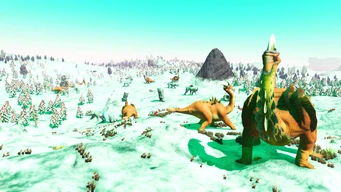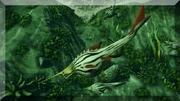| The subject of this article is from the Visions update.
The information from this article is up-to-date as of 13 August, 2019. |
The information from this article is up-to-date as of 13 August, 2019.

The Caesarus, largest currently documented fauna species. (Extinct after Update 1.30.)
Fauna includes all lifeforms capable of free movement.
Summary
In No Man's Sky, Fauna is the "umbrella category" which includes all lifeforms capable of moving around the environment on their own. Although the strictest definition could be used to describe humanoid life (Gek, Korvax, Vy'keen, and possibly Travellers), "fauna" is not usually used to describe humanoids.
Their location can be easily identified on a scanner as red dots (new species), green dots (already scanned), or white dots (too distant to spawn yet). Most species also vocalize (with roars, "yells," squeals, etc). Fauna can be found anywhere on a planet, including in the air, although some planets will have no fauna or areas with no fauna.
Upon landing on a new planet or checking a planet in the Discovery Menu (Pause Menu), the density of fauna (or lack of fauna) on a planet can be checked.
This category is commonly referred to as "animals," which may or may not be technically correct. In Earth biology, "animal" refers to Kingdom Animalia, which the majority of No Man's Sky fauna do indeed seem to resemble.
For records on the largest and smallest fauna in the game, see Fauna Hall of Fame.
Gender
Fauna in No Man's Sky display 16 genders. Below is a list of all genders, and some possible meanings.
- Male-The masculine part of reproduction
- Female-The feminine part of reproduction
- Exotic
- Unknown- The gender of this animal isn't known
- Indeterminate
- Asymmetric - This may be the same as "hermaphroditic" in Earth biology, organisms that are of the same sex and can perform either or both sides of the mating act, like most snails.
- Non-uniform
- Symmetric - Perhaps similar to asexual reproduction in Earth biology.
- Rational
- Vectorized - Possibly relating to viruses, "a vector is an organism that does not cause disease itself but which spreads infection by conveying pathogens from one host to another." Replace "disease" with "pregnancy" and that may be how these organisms reproduce.
- Prime
- Alpha- Similiar to silverback gorillas on Earth
- Radical
- Asymptotic - In geometry, the definition of asymptotic is "a line that approaches a curve but never touches."
- Orthogonal - In geometry, this means "Of two objects, at right angles; perpendicular to each other."
- {undefined} - This displays as "None" in the Discovery info.
Terrestrial fauna species always have two sexes. Aquatic fauna, flying fauna, and butterflies always have one sex.
Sex v.s Gender in sentient species
Individuals of sentient species are mostly, if not always, referred to by the English gender-neutral pronoun "they". This suggests that these species might possess genders different from male and female, a design choice likely made to convey the idea of cultural abundance in alien species, thus approximating them to humanity in a societal/cultural level.
Age
Fauna age in 10 different ways. Below is a list of all age categories, and some possible meanings.
- Immature: Infant, Young, Juvenile
- Mature: Adult, Mature, Elderly
- Other: Indeterminate (Age or aging pattern unknown), Constant (Possibly means they never age), Fluctuating (May be able to change their "age" based on their lifecycle, like some jellyfish), Perpetual (Possibly "continually aging, never dying," effectively "immortal.")
Diets
Fauna can follow 9 dietary patterns, divided into 3 subgroups.
- Carnivore: Carnivore, Meat-Eater
- Herbivore: Vegetation, Oxide Elements, Absorbed Nutrients, Herbivore, Grazing Creature
- Omnivore: Scavenger, Insect-eater
Carnivorous and omnivorous species will be hostile to the player, and sometimes other fauna. Herbivorous species will display grazing animations, perhaps most noticeable with Rangifae (diplos) which lower their heads down to the ground with their long necks.
Some of these categories may seem redundant - for example, "Carnivore" and "Meat-eater," or "Herbivore" and "Grazing Creature." However, there could be slight distinctions between each option.
As a completely speculative example of possible distinctions, "Carnivore" may be the same as "obligate carnivore" in Earth biology, animals that strictly eat meat and nothing else. While "Meat-eater" may be the same as "facultative carnivore," animals that eat mostly meat, but may occasionally eat plants as well (or in the case of NMS, other...elements). "Herbivore" could apply to any animal which eats plants, while "Grazing Creature" might specifically requires grazing behavior.
Height & Weight
The overall size of a species is determined by two factors: its height (or length) and its weight. As weight has no direct effect on the game and seems to give unusual values at times (such as butterflies being extremely dense), height is usually considered the more important characteristic.
Height is a measurement of how tall a species is. So far, none above 8.43m have been confirmed. 8 meters can be considered the "soft limit," as it seems no species will grow much taller than that. The smallest known species is 0.07m. Different genera have different size limits, primarily governed by their ecosystem (for example, there are no flying or aquatic fauna above 4m, and certainly none above 8m).
Weight is a measurement of how heavy a species is. It's difficult to say how it's determined, as the smallest species found so far is as heavy as some species ~14 times their size.
Megafauna

Megafauna.
At a certain size, a species will shake the ground with its footsteps (with the exception of hovering fauna, like winged Grunts or hovering Beetles). Such species are referred to as megafauna. Only certain fauna can become megafauna - aquatic species, birds, and butterflies have a smaller "maximum size" than other types of fauna, and cannot grow to a true "megafauna size."
"Megafauna" is not a term used by the game, but the term is frequently used by the playerbase.
Ecosystems
Fauna can be found in four (technically five) ecosystems.
- Ground (Terrestrial & Hovering) - While you may think Hovering species would be in the Air ecosystem, they're actually bound to the ground.
- Air (Flying) - Wraiths / flying snake-like species, and flying winged species both large and small.
- Water (Aquatic) - Fish, predatory fish, jellyfish, segmented aquatic worms, aquatic mammals, shrimp-like species, etc.
- Caves (Subterranean) - Subterranean species are strictly blobs, arachnid/crustacean-like species, and rodent-like species.
- Sentinels - This is the "only technically an ecosystem." Sentinels are also the only entities allowed to freely cross between ecosystems, although actual fauna may cross between them occasionally or by accident.
Activity Periods: Nocturnal / Diurnal Behavior
The day and night cycle affects the spawning of fauna. Different species will behave differently based on the time of day.
Nocturnal species are active strictly at night. Diurnal is the opposite, with these species only being found during the day. Many species are mostly nocturnal or mostly diurnal, being more active during a certain time but still present during the rest of the day. Creatures won't suddenly disappear if time cycles out of their period of activity, but they will start/stop spawning new ones or increase/decrease their spawning frequency.
The following information is based on pre-Foundation datamining, but it appears to still be accurate. So far, it appears that no updates have significantly changed how fauna spawning and behavior work, aside from increasing the maximum size of fauna.
- Some flying fauna will be less active or entirely inactive at night. There are no nocturnal or mostly-nocturnal flying fauna.
- Butterflies on any planet are strictly diurnal.
- On most planets, predators are more active at night. They can be up to 8 times more active, or even entirely nocturnal.
- The opposite is true on a smaller number planets - like "dinosaur planets." Certain predatory species will be four times more active during the day, or strictly diurnal.
- A very small number of passive species are strictly nocturnal; a larger number are strictly diurnal.
- Many passive species are more active during the day than during the night, but still active at night. Some are unaffected by the time of day.
- Aquatic & subterranean fauna are consistently active during all times of day and night.
Temperament: Predatory / Defensive Behaviors
Fauna can display both predatory and defensive behaviors.
Defensive behavior may occur in the form of self-defense, or in the form of defending their young. These are the only two known patterns of defensive behavior. It appears fauna only defend themselves against the player, not against predators.
Predatory behavior can be directed at the player or other fauna. There are three main types of predators, and two other categories of fauna behavior.
- Predator - A standard predator, this will attack any species classified as "prey," as well as the player.
- PlayerPredator - These predators will only attack the player, not other fauna. PlayerPredators are usually small.
- Aquatic Predators / Sharks - These predators do not appear to attack other aquatic life, but will attack the player.
- Prey - Prey species are ordinarily non-hostile, but will defend themselves if attacked by the player. Prey species will also defend their young, attacking the player if the player harms a young member of the species.
- Passive - Passive species are non-hostile species that will only flee when attacked; they will not defend themselves under any circumstances.
Temperament List
Fauna also display Temperaments, listed in the Discovery Menu. There are 37 Temperaments divided into 5 subcategories. At this time, it's unclear if specific Temperaments within a category have any effect on the behavior of the fauna, or if all subcategories behave essentially the same.
"Generic" temperaments most likely apply to fauna which display neither predatory nor defensive behavior, such as Ictaloris (fish) or Oxyacta (wraiths).
- Generic: Unintelligent, Migratory, Hibernator, Distinctive, Active, Erratic, Unpredictable, Bold, Sedate
- Passive: Passive, Ambulatory, Submissive, Docile, Amenable, Calm, Unconcerned
- Prey: Prey, Skittish, Timid, Fearful, Shy, Cautious, Defensive, Anxious
- Player Predator: Violent, Dangerous, Vicious, Aggressive, Hostile, Cruel
- Predator: Predator, Hunting, Stalking, Unpredictable, Volatile
As Predators and PlayerPredators have distinct temperaments, this list can be used to determined whether or not a specific species will attack other fauna or only the player.
Divisions & Scientific Name
The broad category of fauna is further divided into three smaller categories based on Earth taxonomy. From most to least broad, these categories are Family, Genus,, and Species. The entire game has a total of 23 genera, while an individual family or species never appears on more than one planet.
Using the information below the player can more accurately name their planet's animals.
Family
(Note: In Earth biology, "Family" is a more broad category than "Genus.")
Families in No Man's Sky are much more broad than they are in Earth biology, but they do share some characteristics. For example, on the planet Galactic Hub Summer Embassy, all Oxyacta species belong to the Idiumptu family, and two aquatic species belong to the Kaspers family.
Unlike "Genus" and "Species," "Family" is not an actual term used by the game code, but nonetheless a useful term to describe the identical name parts between some species.
The family of a species can be identified by the second half of its scientific name. For example, the Rigatori Niplatea species would belong to the Niplatea family.
Genus
Genus (pl. genera) is a characteristic of fauna in No Man's Sky. Unlike the procedurally-generated Family characteristic, the game's code references the Genus characteristic in determining where a species spawns. For example, the game will always spawn one butterfly species (genus Rhopalocera) and two predatory T-Rex species (genus Tyranocae) on "prehistoric planets." A genus is also restricted to one (or in some cases two) ecosystems, ie, "Aquatic" or "Subterranean."
Species & Family
These groups appear to be isolated to one planet - a species or family will never appear on two different planets. The name for each creature contains two procedurally-generated parts: a unique Species name (the first half) and a Family name (the second half).
Families in No Man's Sky are much more broad than they are in Earth biology, but they do share some characteristics. For example, one family may all be water dwellers, and others seem to all be four-legged terrestrial creatures. Unlike "Genus" and "Species," "Family" is not an actual term used by the game code, but nonetheless a useful term to describe the identical name parts between some species.
Examples of Families and Common Traits
- Bahalbus - Passive, quadrupedal terrestrial species.
- Ouisque - Beaked, flying bird-like species.
- Sitalie - Fish-like species with stripes / spots.
- Ubsans - Passive, quadrupedal terrestrial species.
Species & Gender
Besides gender, species is the most specific category of fauna. Each species has one or two genders: flying fauna always have one gender, terrestrial fauna always have two genders. Aquatic fauna always have one gender, with the exception of the Prionacefda genus, which may have two separate-but-identical genders. They show up as separate in the Discovery scan, but will have exactly the same information and appearance.
A species can be identified from other members of the same family be the first half of its scientific name. For example, the Rigatori Niplatea species would belong to the rigatori species.
In Earth taxonomy, the 'species' part of classification is always lower case.
Using Taxonomy

Acocuppl Hobell.
Using the information on family, genus, and species above, one can classify the Rigatori Nipatea as Niplatea (family), Rangifae (genus), and finally rigatori (species). The specific species, when being talked about, would then be simply referred to as "R. rigatori." This is called the scientific name, or the binomial nomenclature.
To help further explain this process, here are a few more examples of classifying a species.
- Evectagu Saviso: Saviso (family), Tetraceris (genus), evectagu (species). T. evectagu.
- Acocuppl Hobell: Hobell (family), Icaloris (genus), acocuppl (species). I. acocuppl.
- Befecus Nidustares: Nidustares (family), Ungulatis (genus), befecus (species). U. befecus.
